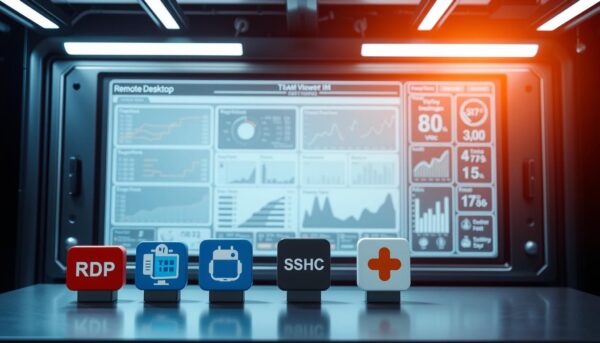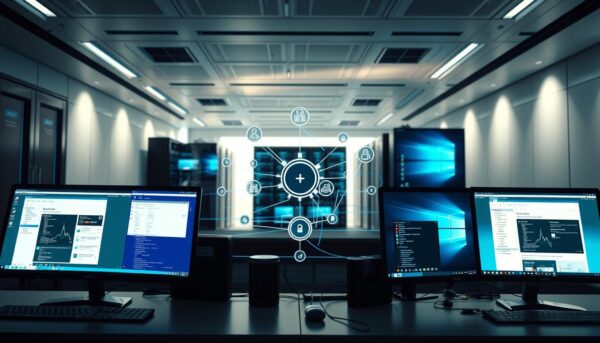✅ Last checked on
What if you could control a computer miles away as if you were sitting right in front of it? The Remote Desktop Protocol (RDP) makes this possible, transforming how businesses and individuals interact with technology. Developed by Microsoft, this secure network solution lets you access applications, files, and entire systems from any location using your local device.
Imagine troubleshooting a server in another state or accessing your office computer while traveling. The protocol establishes an encrypted connection between devices, ensuring sensitive data stays protected. It’s like having a digital bridge that mirrors your keyboard, mouse, and screen to another machine in real time.
Over 75% of IT teams rely on remote desktop tools for system management. Whether you’re supporting colleagues or managing cloud-based resources, this technology eliminates geographical barriers. But how does it maintain security while delivering such flexibility? The answer lies in advanced encryption and authentication measures that guard every interaction.
Key Takeaways
- Securely access computers from any device using encrypted network connections
- Interact with remote systems as if you’re physically present at the machine
- Microsoft-developed protocol trusted by organizations worldwide since 1996
- Enables IT support, remote work, and centralized data management
- Requires proper firewall configuration and security best practices
What is Remote Desktop Protocol (RDP)?
The digital workspace transformed dramatically when Microsoft introduced its remote access solution in 1996. Designed initially for Windows NT 4.0 Terminal Server, this technology evolved into the backbone of modern remote workflows. Today, it powers everything from IT troubleshooting to hybrid work models.

From Terminal Services to Modern Connectivity
Microsoft built this protocol to enable centralized management of Windows Server environments. Unlike basic screen-sharing tools, it transmits compressed data packets instead of raw screen images. This approach reduces bandwidth use while maintaining crisp visual quality.
Standout Features Compared to Alternatives
Other remote access methods like VNC create direct device-to-device links. But this protocol connects through terminal servers, enabling smoother multi-user support. Cloud platforms let you access stored files, while remote desktop tools give full control over applications and system settings.
| Feature | Remote Desktop Protocol | VNC/Cloud Solutions |
|---|---|---|
| Connection Type | Terminal server-based | Direct device or cloud storage |
| Performance | Optimized for Windows networks | Platform-agnostic |
| Security | Enterprise-grade encryption | Varies by provider |
| Resource Sharing | Printers, drives, audio | Limited file transfer |
For teams needing secure remote access, the protocol’s integration with Active Directory simplifies permissions. You can manage user sessions centrally while maintaining strict security policies. Printer redirection and local resource sharing further streamline daily tasks.
How RDP Works
Connecting to a remote desktop isn’t magic—it’s a carefully orchestrated dance between two machines. The system relies on three core components working together: specialized software architecture, optimized network pathways, and military-grade security measures.
The Client-Server Architecture
Your local device acts as the client, sending requests through remote desktop software. The host machine (server) processes these commands using terminal services technology. This setup allows multiple users to access shared resources without installing software on their personal devices.
Network Communication and Port 3389
All communication flows through TCP port 3389 by default, creating a dedicated tunnel for remote control. The protocol uses both TCP/IP for reliable data delivery and UDP for real-time screen updates. Firewalls must permit this port for connections to succeed.
Encryption and Data Transmission
Before any information travels, TLS 1.3 encryption establishes a secure channel through a process called network-level authentication. Modern versions use this method instead of older RC4 standards, compressing data before encryption to maintain speed. Every keystroke and mouse movement gets wrapped in protective layers—like sending sealed documents through armored trucks.
This combination of efficient networking and robust security lets you work remotely while keeping sensitive information safe. Proper configuration ensures the encryption protocols update automatically, defending against evolving cyber threats.
Key Features and Capabilities of RDP
Productivity soars when your tools adapt to your workflow rather than limit it. Modern remote access technology delivers seamless multi-screen environments and intelligent session controls that mirror local computing experiences.

Multi-Monitor Support
Work across screens like you’re physically present. The system automatically detects your local monitor setup and mirrors it remotely. Whether using two 4K displays or a laptop-tablet combo, applications adjust to your screen layout without manual configuration.
Session Management
Ever needed to pause work abruptly? Administrators can disconnect from active sessions without closing applications. Reconnect later from any device to resume exactly where you left off. This feature proves invaluable during network hiccups or when switching between office and mobile setups.
“Session persistence transformed how we handle field technicians. They reconnect to half-finished tasks without losing progress.”
| Feature | Local Setup | Remote Access |
|---|---|---|
| Display Configuration | Manual adjustment | Automatic detection |
| Session Handling | Single device | Cross-device resumption |
| Resource Access | Direct hardware | Redirected printers/drives |
| Security | Physical controls | Encrypted channels |
Timeout settings help balance security and convenience. Idle sessions disconnect after set periods while preserving work states. For collaborative support, authorized users can view or control active sessions without interrupting workflows.
RDP Security Considerations
How safe is your digital doorway to work systems? While remote desktop tools offer convenience, they can become entry points for cyber threats if not properly secured. Recent studies show 34% of data breaches start with compromised remote access points.
Common Vulnerabilities and Threats
Attackers often target outdated systems using methods like brute-force password guessing. The BlueKeep vulnerability demonstrated how unpatched software lets hackers take full control of devices. Default port 3389 acts like a neon sign for automated scanning tools probing for weaknesses.
| Risk Factor | Impact | Solution |
|---|---|---|
| Weak Passwords | Unauthorized access | 14+ character mixes |
| Open Port 3389 | Botnet attacks | Firewall restrictions |
| Legacy Systems | Exploit vulnerabilities | Network segmentation |
| Missing 2FA | Credential theft | Mobile authenticators |
Best Practices for Securing Connections
Start by enabling network-level authentication to verify users before granting access. Combine this with multi-factor authentication—a text code or app notification adds critical protection against stolen passwords.
For home offices, securing remote desktop connections often involves VPNs and IP whitelisting. Enterprise teams should use jump servers to isolate sensitive systems from direct internet exposure.
Regular updates patch security holes automatically. Set reminders to check for Microsoft’s monthly patches—especially for older systems still in use. Remember: convenience shouldn’t outweigh protection when configuring remote access tools.
Conclusion: The Future of Remote Desktop Access
The landscape of remote access keeps evolving as hybrid work becomes standard. Microsoft’s protocol adapts to support emerging network types and faster connections. With 5G rolling out globally, expect smoother interactions when managing applications across servers.
Security remains central to updates. Future versions will likely integrate AI to detect unusual login patterns automatically. Imagine your device adjusting encryption levels based on network risks without manual input.
Cloud-based management tools simplify how teams handle multiple users. Administrators can deploy updates or restrict access through centralized dashboards. This approach maintains security while supporting diverse devices – from tablets to thin clients.
Developers benefit from abstraction layers that let them focus on functionality rather than connection logistics. As more organizations blend cloud and physical servers, the protocol serves as a universal bridge. Your workflows stay consistent whether accessing files locally or through remote desktop services.
What won’t change? The need for reliable, secure access to critical systems. Continuous improvements ensure this technology remains essential for businesses embracing flexible work models.